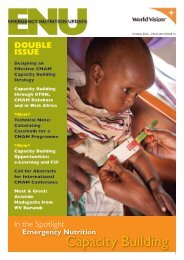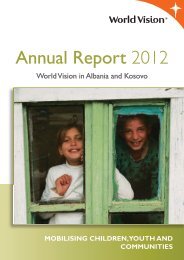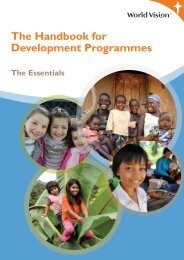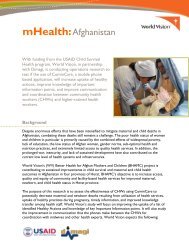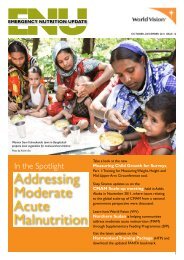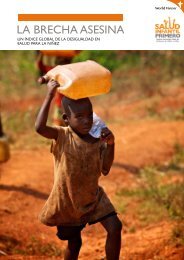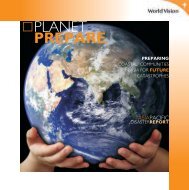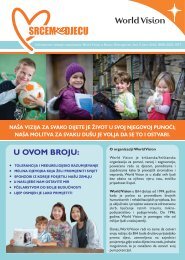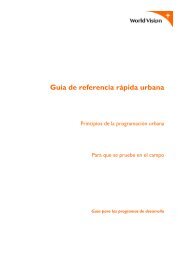the right to inclusive education for children with disabilities
the right to inclusive education for children with disabilities
the right to inclusive education for children with disabilities
You also want an ePaper? Increase the reach of your titles
YUMPU automatically turns print PDFs into web optimized ePapers that Google loves.
circumstances that are already known. They returned, <strong>to</strong> complete <strong>the</strong>ir <strong>education</strong> in Albania. The first twoteachers who brought <strong>the</strong> experience gained <strong>the</strong>re (in SU) in special <strong>education</strong> were Mrs. Liri Panajotiwho specialized in applying Braille system <strong>for</strong> <strong>children</strong> <strong>with</strong> visual <strong>disabilities</strong> and Znj. Bedrije Tare, whospecialized in <strong>the</strong> field of dactylology. After she returned from <strong>the</strong> Soviet Union, she adopted <strong>the</strong> Albaniandactylology <strong>to</strong> 36 phonemes of <strong>the</strong> Albanian language.early <strong>education</strong> of <strong>children</strong> and youth <strong>with</strong> visual impairment in albania, is in <strong>the</strong> first placerelated <strong>to</strong> ef<strong>for</strong>ts <strong>to</strong> teach special writing, Braille, <strong>for</strong> <strong>the</strong>se individuals, and secondly <strong>with</strong> <strong>the</strong>ir involvementin arts <strong>education</strong> in music, as players of musical instruments or as singers. In <strong>the</strong>se years <strong>the</strong>re were sent<strong>to</strong> study at schools of music in <strong>the</strong> Soviet Union and o<strong>the</strong>r countries, a certain number of individuals <strong>with</strong>visual <strong>disabilities</strong>. In general <strong>the</strong>se were students who were involved directly only in professional <strong>education</strong>mainly in piano, accordion, and aerophones. They had not attended primary or <strong>the</strong> 7-year school systemof that time. While some individuals <strong>with</strong> visual <strong>disabilities</strong> exercised already <strong>the</strong> profession of a singer orplayers of musical instruments.So, <strong>the</strong> general public readily admitted that <strong>the</strong>se individuals had <strong>the</strong> ability and capacity in <strong>the</strong> field ofmusic and consequently <strong>the</strong>ir <strong>education</strong> in this area did not constitute a problem. Promotion of <strong>the</strong>semodels as well as in<strong>for</strong>mation streaming from <strong>the</strong> Soviet Union and o<strong>the</strong>r countries of what was than <strong>the</strong>socialist camp, encouraged <strong>the</strong> leaders of <strong>the</strong> Ministry of Education of that time <strong>to</strong> consider creating special<strong>education</strong>al institutions like those already existing in <strong>the</strong> o<strong>the</strong>r socialist countries.under <strong>the</strong>se conditions, through dcM, no. 160, dated april 29, 1963, <strong>the</strong> Albanian governmentdecided <strong>to</strong> open <strong>the</strong> first Institute <strong>for</strong> special <strong>education</strong> in both categories of persons <strong>with</strong> <strong>disabilities</strong>,students who did not see and students who did not hear. The opening of this Institute was made possibleonly 7 months after <strong>the</strong> decision. november 5, 1963 opened <strong>the</strong> doors <strong>for</strong> <strong>the</strong> first time in <strong>the</strong> his<strong>to</strong>ryof <strong>the</strong> Albanian special <strong>education</strong>, <strong>the</strong> Institute of Deaf and Blind Students, who at that time was called<strong>the</strong> Institute <strong>for</strong> Deaf-mute and <strong>the</strong> Blind. The Ministry of Education of that time, decided <strong>to</strong> import aPerkins Braille typewriter which was provided <strong>the</strong> Institute <strong>for</strong> Deaf-mute and <strong>the</strong> Blind. (The first teacher<strong>for</strong> students <strong>with</strong> visual impairment in Albania was educated partly in defec<strong>to</strong>logy branch in Leningrad in1958). With <strong>the</strong> opening of school in November 5, 1963 <strong>the</strong>re was already prepared <strong>the</strong> first primer andarithmetic in Braille. These books came illustrated <strong>with</strong> pictures. The first teachers who worked at <strong>the</strong>institute brought <strong>the</strong> experience <strong>the</strong>y had acquired from <strong>the</strong>ir schooling in Leningrad, which would laterserve as <strong>the</strong> foundation upon which <strong>the</strong> <strong>education</strong> of this category of students would be built.The first texts in Braille started <strong>to</strong> being typed also by teachers <strong>the</strong>mselves, who after that, would hand <strong>the</strong>m<strong>to</strong> students on specific <strong>to</strong>pics or chapters basis. Life of this Institute began <strong>with</strong> an opening of two classrooms,one <strong>for</strong> blind students (12 students) and ano<strong>the</strong>r <strong>for</strong> deaf students (10 students). Administrative criteria <strong>for</strong>admission were: students who did not see, <strong>the</strong>y should have been blind but that not accompanied <strong>with</strong> o<strong>the</strong>rdevelopmental problems. The same criterion was applied also <strong>for</strong> deaf students. Among <strong>the</strong> most importan<strong>to</strong>bjectives that found application in that time <strong>for</strong> <strong>the</strong> <strong>education</strong> of <strong>children</strong> who do not see, it has beenequipping students <strong>with</strong> <strong>the</strong> full scope of knowledge <strong>for</strong> <strong>the</strong>ir 8-year <strong>education</strong>, while <strong>for</strong> students <strong>with</strong> hearingimpairments, would apply <strong>the</strong> elementary curriculum, but extended <strong>to</strong> 8 - 9 years of school.Image from <strong>the</strong> Institute of deaf students.As seen from <strong>the</strong> picture, students of this institute arewearing <strong>the</strong> standard uni<strong>for</strong>m of that time that was usedin all Albanian schools (black gowns <strong>with</strong> white collar andred pioneer scarves). This element was among <strong>the</strong> fewthat approximated <strong>the</strong>se students <strong>with</strong> students from o<strong>the</strong>rschools.18 The <strong>right</strong> <strong>to</strong> Inclusive Education <strong>for</strong> <strong>children</strong> <strong>with</strong> Disabilities



